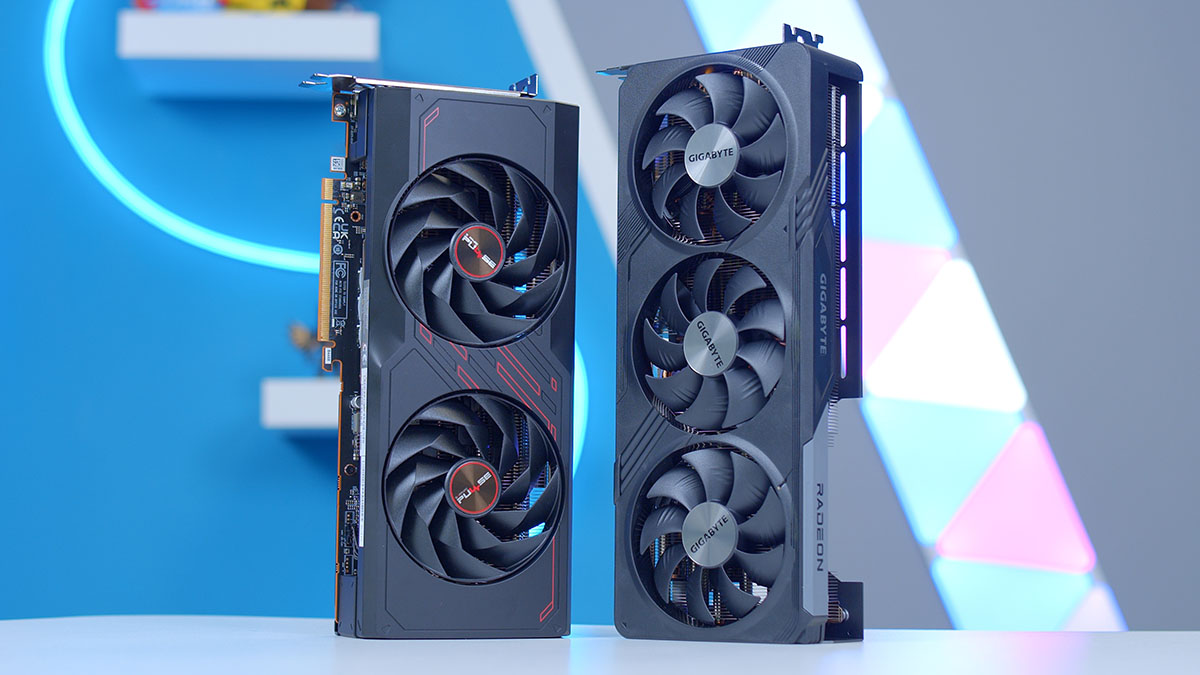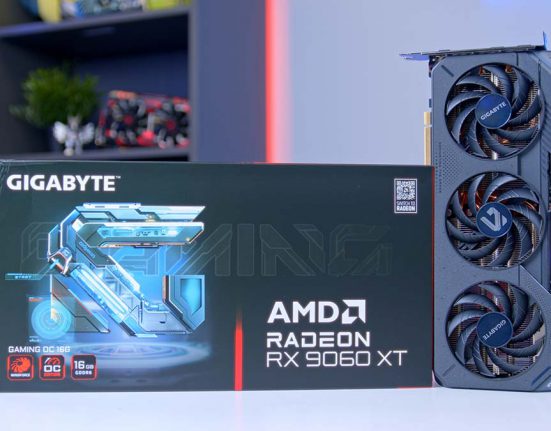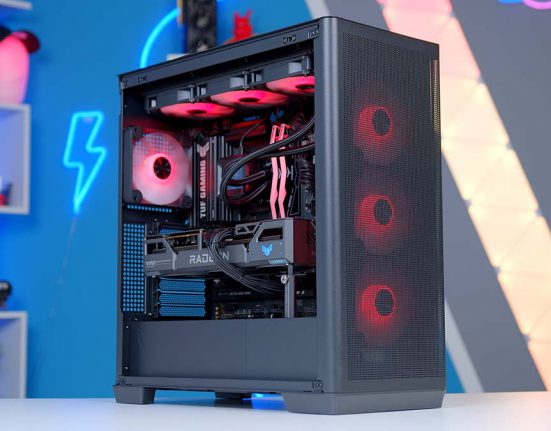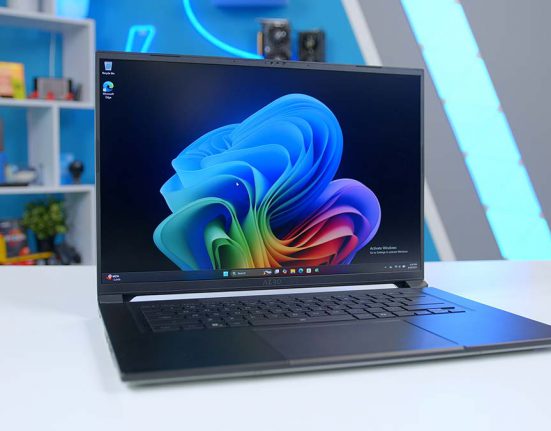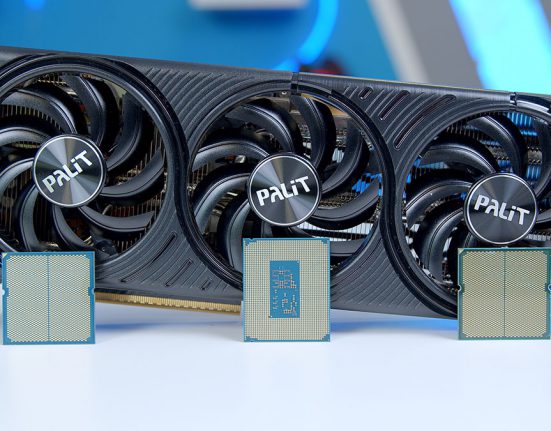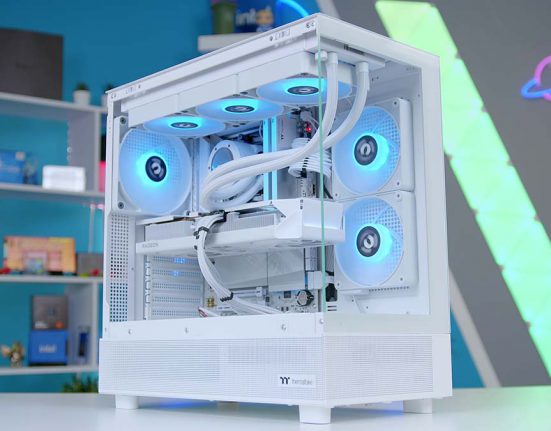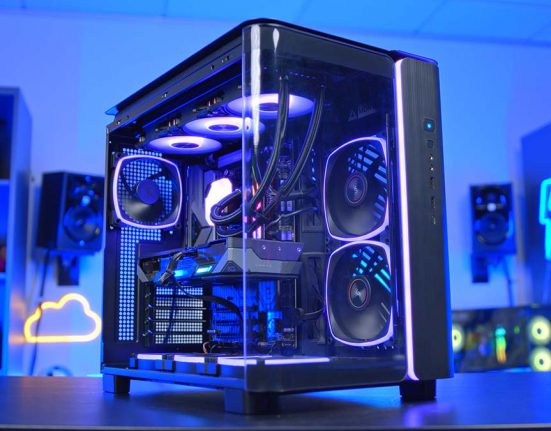AMD’s Radeon RX 7700 XT and 7800 XT have launched, and for the most part, these cards have been received pretty well in the PC building community. AMD has priced both of these options pretty competitively, undercutting NVIDIA in the mid-range market, making them incredibly worthwhile for those looking to build a ‘middle-of-the-road’, which I’d categorise as a nice balance of pricing and performance. AMD’s Radeon 7000 cards have generally been met with more positivity in this space, due to their stronger value for money versus NVIDIA’s alternatives.
Naturally though, the mid-range market can be rather difficult to please, as these cards need to provide decent performance metrics, but at a price that the vast majority of consumers wouldn’t necessarily be comfortable with spending. And this is why the 7700 XT and 7800 XT are such solid options, but which is better? In this GPU versus article we’ll be answering this very question. We’ll be delving into the architecture, hardware, and performance of each card, while also providing some of our recommendations too.
Suggested Article: Gigabyte Gaming OC Radeon RX 7800 XT Review – Worth the Purchase?
GPU Versus Battle
AMD Radeon RX 7700 XT
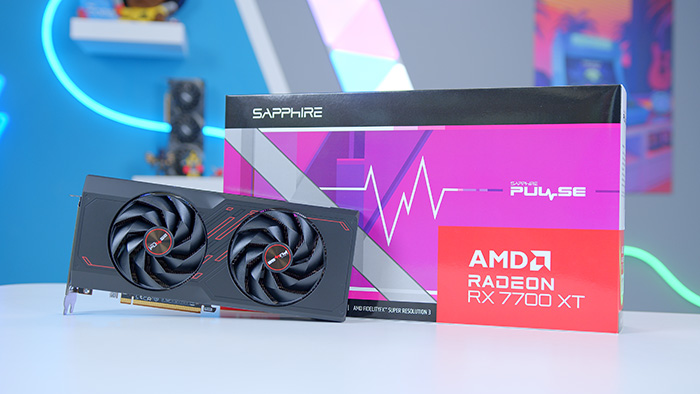
| Memory Capacity | 12GB GDDR6 |
| Boost Clock Speed | 2.54GHz |
| Ray Accelerators | 54 |
| Stream Processors | 3456 |
| TDP | 245W |
| Release Date | September 2023 |
| Price | Check Price on Amazon |
AMD’s Radeon RX 7700 XT was one of the highly anticipated cards of this year, coming in at an exceptionally tantalising price point versus the rest of the market. The vast majority of consumers have been waiting for a modern mid-range card to offer decent value, and since NVIDIA have absolutely failed on that front, the onus is on AMD to deliver. With the exceptional value-proposition that Radeon 6000 cards offer, it makes perfect sense that their new options would come in at an equally awesome price point.
The 7700 XT has an MSRP of $449, which sits a fair bit below the original MSRP price points of the 6700 XT and 6750 XT. It is worth noting that some AIB models will be priced higher than this, which will be a bit of a turn-off for some consumers. But despite this, we think the 7700 XT comes in with a more than reasonable price tag, especially when we compare against other modern options from the likes of NVIDIA and Intel. When we look at performance, I do feel the value versus the 7800 XT starts to drop a little bit, as this card is more geared towards 1080p and 1440p. Although we found the 1440p metrics to be pretty decent, you may find yourself tweaking the in-game settings to ensure you can enjoy high framerates.
Moving onto hardware, as we’ll be taking a look at performance later. The 7700 XT is equipped with 12GB of VRAM and a boost clock speed that reaches 2.54GHz, which is pretty strong. Boost clocks will vary dependent on the card that you’ve picked up, as AIB models do provide a factory overclock. The most important hardware feature to note here is the increased VRAM versus the vast majority of mid-range cards on the market. 8GB is proving to be too little for gaming nowadays, so 12GB is a perfect middle ground.
AMD Radeon RX 7800 XT
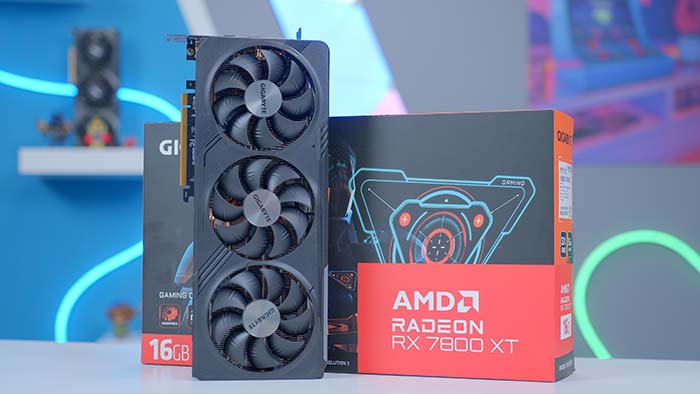
| Memory Capacity | 16GB GDDR6 |
| Boost Clock Speed | 2.43GHz |
| Ray Accelerators | 60 |
| Stream Processors | 3840 |
| TDP | 245W |
| Release Date | September 2023 |
| Price | Check Price on Amazon |
Taking a look at the 7800 XT, this is the card that we were the most excited for out of the two new releases. The 7800 XT stands to offer the best value for money when it comes to pricing and performance metrics. I’d argue the that 7800 XT is a true mid-range graphics card, and really delivers when it comes to value-proposition, and I’d go a step further to say that this is the card most consumers will look to purchase for a mid-range system. NVIDIA really don’t have a leg to stand on versus this new option.
When it comes to pricing, this GPU has an MSRP of $499, which is a $50 increase versus its slightly weaker sibling, the 7700 XT. Regardless of the price increase, I’d say that $499 is pretty fair considering how strong this card is. This is about $100 cheaper than the previous generation’s 6800 XT, which is excellent. AMD definitely looks to be catering to the mid-range market here, with the MSRP of this card significantly undercutting NVIDIA. Performance wise the 7800 XT is definitely a 1440p capable card, with decent legs at 4K too. For only $50 extra, you’re able to leverage hardware that allows you to play games comfortably at 4K, which I’d say is a pretty small price to pay in the grand scheme of things.
Taking a look at the hardware, the 7800 XT has been given a slight boost to the VRAM capacity, with 16GB in total, versus the 12GB that the 7700 XT has. Wattage has increased slightly, with the power consumption sitting around 700W. This does mean you’ll need to pick up a slightly stronger PSU, but 750W options aren’t too expensive. The 7800 XT also isn’t too long either, sitting around 267mm in length, which means most consumers shouldn’t have any major issues when it comes to clearance.

RDNA 3 Architecture – Is it Any Good ?
RDNA3 is AMD‘s latest architecture, and is currently the strongest offering that AMD have presented within the past few years. Their new hardware pushes performance boundaries, with brand new cards striving higher than they have before, with 4K capability, stronger Ray-Tracing performance, and better software.
Software in particular has seen some pretty big leaps and bounds, with the 7700 XT and 7800 XT ushering in FSR 3, along with Fluid Motion Frames, and HYPR-RX, which all provide performance bonuses when enabled. AMD has really stepped up with their software within the past couple of years, offering driver improvements, but all of the new technology really takes the cake.
FSR 3 looks to bring the heat to NVIDIA, offering more stability and performance improvements when switched on. FSR renders in-game pixels at a lower resolution allowing you to enjoy better visual fidelity, but with less stress being imposed on your GPU. FMF furthers this by using something called interpolation, which renders frames in between other frames. This pushes up your framerate even more, continuing to alleviate stress on your graphics card.
Although FSR 3 hasn’t fully saturated the market as of yet, AMD have announced a range of new titles that will include this new tech, allowing you to enjoy smooth framerates across the board. It’ll be interesting to see how FSR 3 performs in newer games, as we’ve seen a whole host of them suffer from poor optimisation issues. Hopefully FSR 3 will improve performance a fair bit in these games, allowing consumers to enjoy higher framerates.
RDNA 3 is an incredibly strong architecture, and puts AMD on top versus NVIDIA in a lot of cases. There are areas that AMD needs to improve on, such as Ray-Tracing capability. But because Ray-Tracing as a technology is still in the early stages of its life, I feel most consumers won’t worry about this. Regardless, if you do plan on playing games with Ray-Tracing turned on, we’d recommend you take a look at some slightly more powerful GPUs.
Our Favourite Radeon RX 7700 XT GPU
1. Sapphire Pulse Radeon RX 7700 XT
👑The best value 7700 XT graphics card.

Our favourite 7700 XT graphics card is the Sapphire Pulse model, an excellent MSRP GPU. Although the 7700 XT is a weaker card versus the 7800 XT, we feel that the Sapphire Pulse model offers some of the best value, if you are insistent on picking up this particular model. This particular GPU is one of the smaller options on the market, sitting at 280mm in length. This means you shouldn’t have any major problems when it comes to clearance. The red accenting on the card provides some nice contrast versus some of the other more boring cards too, spicing up the design of your build a bit.
Key Specs
| Key Specs | Sapphire Pulse Radeon RX 7700 XT |
|---|---|
| Video Memory | 12GB GDDR6 |
| Memory Bus | 192 bit |
| Base Clock Speed | 2.27GHz |
| Boost Clock Speed | 2.54GHz |
| Stream Processors | 3456 |
| Power Consumption | 230W |
| Ray Accelerators | 54 |
| PCI-E Generation | PCI-E 4.0 |
| GPU Length | 280mm |
| Fans | 2 |
| RGB | No |
Things We Like
Solid 1080p and 1440p performance: The 7700 XT is primarily geared towards 1080p and 1440p gaming, and offers exceptionally strong framerates at both of these resolutions.
Sapphire Pulse is an MSRP card: This card is available for MSRP, which is what makes it such a worthwhile option. The 7700 XT is a strong value card because of its price point, which is why we’ve picked out this particular model.
Things We Don’t Like
Doesn’t offer a factory overclock: Unfortunately, the Sapphire Pulse 7700 XT isn’t an OC model, so it’s boost speed will be the same as a reference card. This means you’ll be missing out on some performance bonuses.
Only a 2 fan card: Although the size of this GPU is definitely preferable, the fact that the Sapphire Pulse 7700 XT is a two fan option, could hinder thermal performance to a degree.
Summary
Sapphire’s Pulse Radeon RX 7700 XT is one of the best cards of this particular model, coming in at MSRP, offering solid performance, whilst also sitting at a size that won’t cause any clearance problems. It isn’t the best looking and it isn’t overclocked, but I feel based on the pricing of this GPU, most consumers won’t consider this an issue.
Features: 4.1/5
Design: 4.3/5
Performance: 4.4/5
Value for Money: 4.4/5
Where to Buy
Buy the Sapphire Pulse Radeon RX 7700 XT on:
Our Favourite Radeon RX 7800 XT GPU
2. Gigabyte Gaming OC Radeon RX 7800 XT
👑The best value 7800 XT GPU.
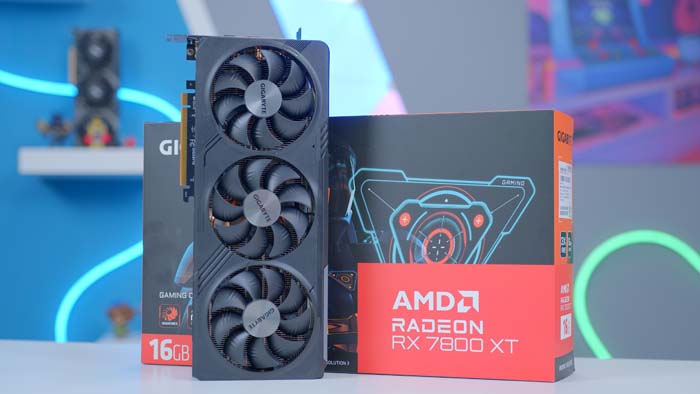
For our favourite 7800 XT option, we’ve picked out the Gaming OC variant from Gigabyte. This particular card is one of the bigger AIB options on the market, but despite being an aftermarket card, it comes in at a very reasonable MSRP price point. Gaming OC cards also come with a small factory overclock which will increase performance by some degree in certain games and applications. This is one of the more boring looking cards that we’ve reviewed, but based on the value-proposition that this card offers, I feel the vast majority of consumers won’t be worrying about how it looks.
Key Specs
| Key Specs | Gigabyte Gaming OC Radeon RX 7800 XT |
|---|---|
| Video Memory | 16GB GDDR6 |
| Memory Bus | 256 bit |
| Base Clock Speed | 1.29GHz |
| Boost Clock Speed | 2.56GHz |
| Stream Processors | 3840 |
| Power Consumption | 263W |
| Ray Accelerators | 60 |
| PCI-E Generation | PCI-E 4.0 |
| GPU Length | 302mm |
| Fans | 3 |
| RGB | Yes |
Things We Like
MSRP price point: During the launch we were expecting this card to come in well above that all-important MSRP price point, but Gigabyte‘s Gaming OC model is surprisingly an MSRP card, making it a great value option.
Triple-fan design: Triple-fan graphics cards are generally more thermally capable due to their larger heatsinks along with having more fans. The Gaming OC card is a pretty strong option, and offers better temperatures in comparison to the smaller dual-fan cards on the market.
Things We Don’t Like
Size may cause clearance problems: Unfortunately, because this GPU is a triple-fan card, it is pretty massive. Size wise the Gaming OC model comes in at 302mm in length, which could cause some clearance issues dependent on the case that you’ve picked out.
Pretty plain looking: Gigabyte’s Gaming OC graphics cards aren’t particularly well known for offering a great aesthetic, and this unfortunately reflects here. This is one of the more boring GPUs on the market, offering a plain grey aesthetic with very minimal RGB located on the top of the card.
Summary
While this isn’t the best looking card on the market right now, the Gigabyte Gaming OC 7800 XT stands to offer exceptional 1440p and 4K gaming performance, whilst keeping your thermals nice and low with the triple-fan design. This GPU is definitely worth considering, if you’re looking for a solid mid-range option.
Features: 4.2/5
Design: 3.9/5
Performance: 4.5/5
Value for Money: 4.6/5
Where to Buy
Buy the Gigabyte Gaming OC Radeon RX 7800 XT on:
How We Tested the RX 7700 XT and RX 7800 XT
As soon as we get wind of any new graphics cards on the horizon, our team of writers and enthusiasts put the new hardware through its paces in a range of different gaming and workstation benchmarks. Our current suite of games includes some of the latest triple A games, along with popular Esports titles, to ensure we get a solid range of performance metrics across a multitude of games.
During all of these runs, we fire up MSI Afterburner and NVIDIA Frameview and record our in-game settings, so consumers can optimise their experience, but also so you can see framerates. We use two programs to make sure that frames are consistent across multiple applications, ensuring that our testing is repeatable, fair, and consistent. A standardised benchmarking system is used to give all GPUs a fair chance when it comes to performance.
Both of AMD‘s new cards, the 7700 XT and 7800 XT were put through the wringer, which highlights the strengths and weaknesses of each card in a variety of different scenarios. These results are then used to forge a general overview on each GPU, highlighting pros and cons of each components.
Gaming Benchmarks
Now that we’ve provided our context and background on each of these GPUs, now is a perfect time to see how they perform in our benchmarking suite. In this section of the article, we’ll be comparing performance numbers side by side in a number of popular games. We’ll also be seeing how these cards stack up against other graphics cards on the market.
Starfield @ 1440 High
Winner – RX 7800 XT
For our first benchmark, we fired up Starfield and played the game at 1440p high settings. Unfortunately, performance in this game seems to be weaker in comparison to other games, and this is likely down to the fact that Starfield isn’t particularly well optimised. The 7800 XT is the winner of this particular benchmark, offering up around 85FPS, which is fine. We obviously expected more from the 7800 XT, but as we’ve said, the performance isn’t exactly down to the card, more due to how unoptimised this title is.
The Radeon RX 7700 XT loses about 10FPS versus the 7800 XT in this benchmark. Again, this game is pretty unoptimised, so we were happy to just see reasonably high framerates that sat above the 60FPS mark.

Apex Legends @ 1440p
Winner – RX 7800 XT
Unsurprisingly the winner of this benchmark was the 7800 XT. In Apex Legends at 1440p high settings, the 7800 XT offered up a whopping 256FPS, which is more than enough for most consumers. Users can enjoy this game at high refresh rates with minimal stutters or tearing. This goes to show how strong the 7800 XT is at 1440p versus the rest of the market.
Taking a look at the 7700 XT, there is a pretty big difference in performance versus the 7800 XT. We’re seeing a disparity of around 80FPS, which is a pretty big drop in performance. Regardless of this, the 7700 XT was still pretty strong overall, consumers can still enjoy a high refresh rate, but those with monitors that sit above 200Hz, are missing out to a degree.

Apex Legends @ 4K
Winner – RX 7800 XT
At 4K, the 7800 XT is still holding firm, beating out the 7700 XT by a fair margin. The 7800 XT sat around the 148FPS mark, which is just above that 144Hz sweet spot that we all love to see. Despite this, we’re obviously seeing reduced performance here because of the higher resolution. This does mean you’ll need to temper expectations to a degree in other titles that aren’t as well optimised.
The 7700 XT does lose out to the 7800 XT by about 40 frames or so, which puts this card well under that 144Hz sweet spot. But we’re still pretty happy with the performance overall. If you mess around with some in-game settings, you might be able to get that performance boost to reach the 144FPS mark to ensure you can enjoy buttery smooth gameplay.

Hogwarts Legacy @ 1080p
Winner – RX 7800 XT
Unsurprisingly the 7800 XT wins again, offering around 128FPS. Hogwarts Legacy is a rather intense title, so as you’ll see from our benchmarks even some of the strongest performing cards on the market aren’t able to surpass the 144FPS mark. Either way, the 7800 XT held strong at 1080p, offering around 128FPS.
The 7700 XT still offered reasonable framerates in this benchmark, capping out at around 111FPS on average. Again, we were hoping for better performance in this particular game, but the framerates are weaker because of how intense this game is. Hogwarts Legacy is another triple A title that needs some more optimisations.

Hogwarts Legacy @ 1440p
Winner – RX 7800 XT
Stepping things up a notch with a 1440p framerate, the 7800 XT is yet again the winner. We saw an average framerate of 109FPS, which isn’t that much of a difference versus our 1080p benchmark. Again, we’re losing out to that 144Hz mark during this game, but I’d say that it isn’t as important compared to more intense FPS and Esports titles.
The 7700 XT still held up pretty well in this game, offering around 92FPS on average. It is a little bit disappointing that we’re sitting below 100FPS during this game, but I’d say that 92FPS is still perfectly fine in terms of gameplay smoothness.

Overwatch 2 @ 1440p
Winner – RX 7800 XT
In Overwatch 2 at 1440p ultra settings, the 7800 XT offered an insane framerate, nearly reaching that 300FPS mark. In terms of averages, the 7800 XT offered up around 288FPS, which is overkill for the most part. The vast majority of consumers won’t need framerates that reach this high, but if you have got a monitor that surpasses the 240Hz mark, then you’ll be reaping the rewards of a smooth display experience.
The 7700 XT in this title offered similar performance to the 7800 XT. With a difference in performance of about 18FPS, we were pretty happy. There isn’t much else to say about the 7700 XT, Much like with our 7800 XT results, there is somewhat of a benefit to super high framerates if you’ve got a high refresh rate display, but for the vast majority of consumers this is overkill.
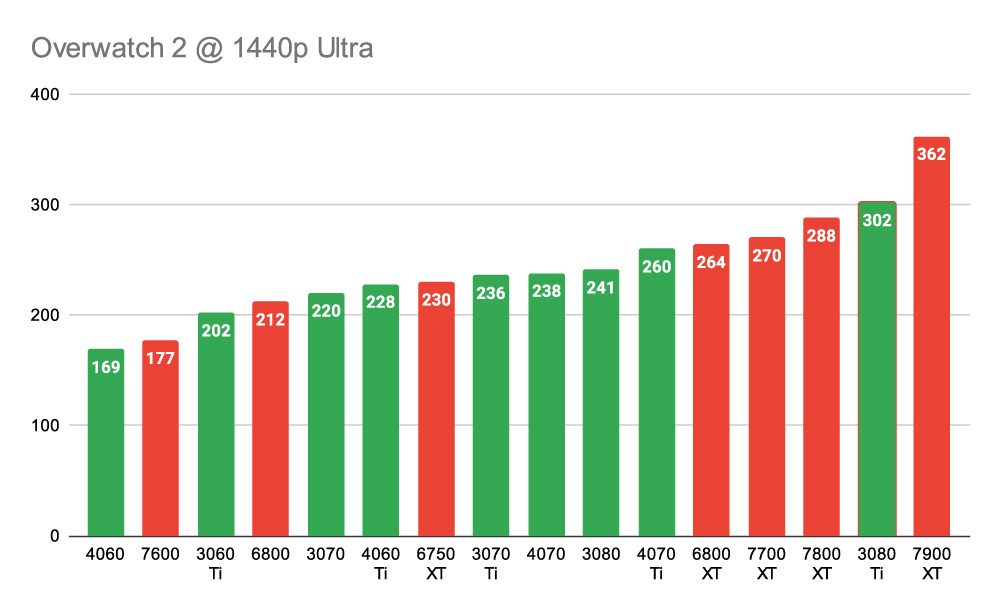
COD MW2 @ 1440p
Winner – RX 7800 XT
For our last benchmark, we fired up COD Modern Warfare 2. In this benchmark we turned on FSR to see if we could leverage some performance enhancements from AMD’s pixel rendering technology. In this title it is difficult to ascertain if FSR is boosting the framerates that much, purely because MW2 can be pretty unoptimised. Regardless, the 7800 XT offered pretty reasonable framerates in this game, with an average of 185FPS. This is more than enough for consumers to enjoy a blazing-fast refresh rate, providing a buttery smooth display experience.
The 7700 XT did lose out by a fair few frames in this title versus the 7800 XT, with the 7700 XT offering up an average of 148FPS. Again, this is more than enough for the majority of consumers, especially at 1440p. COD players will benefit from a high refresh rate, as you’re required to respond to the action in a moment’s notice.
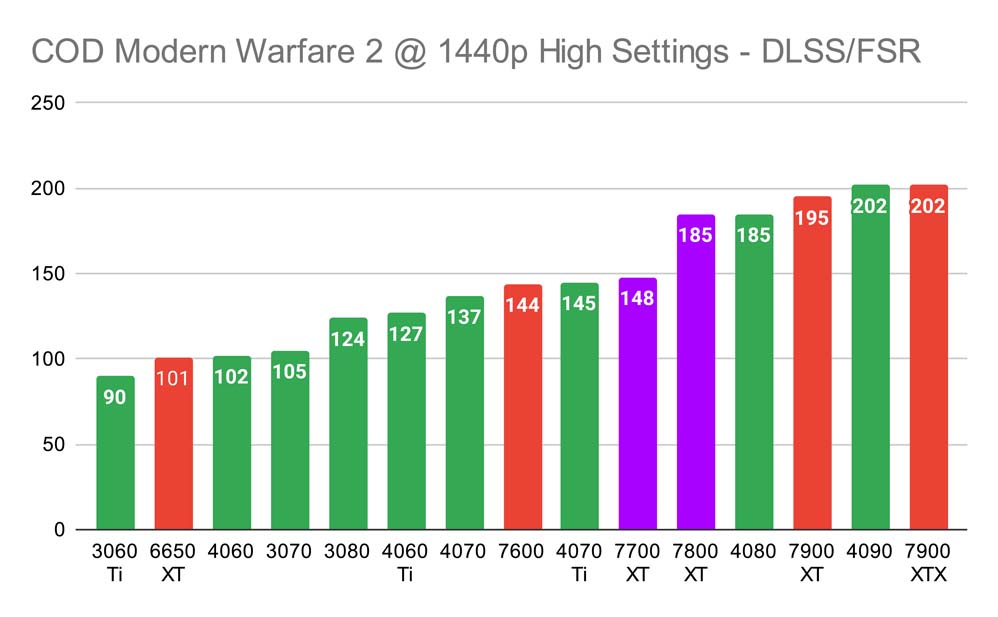

GPU Versus Winner – AMD Radeon RX 7800 XT
After a number of performance benchmarks, architecture and pricing comparisons, the 7800 XT is the clear winner of this GPU versus. While I do believe that the 7700 XT is a solid card for 1080p and 1440p gaming, it isn’t the best option for a mid-range system. It has some solid hardware, and comes in at an affordable price point, but for $50 more, you can pick up a GPU that offers even stronger framerates at 1440p, with decent legroom at 4K. And this is why the 7800 XT is a stronger option.
At the end of the day if you’re willing to spend between $400 and $500 for a graphics card, spending an extra $50 is a small price to pay for a massive upgrade. It is worth noting that the AIB cards that are priced above the $499 MSRP price point aren’t particularly great options, not because of performance, but because of how expensive they are. This aside, if you’re looking to pick up a solid mid-range graphics card, the 7800 XT is one of the best options right now, and is well worth considering versus other market alternatives.
Buy the AMD Radeon RX 7700 XT on:
Buy the AMD Radeon RX 7800 XT on:


